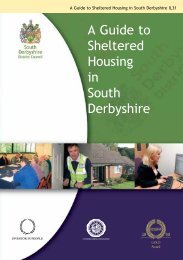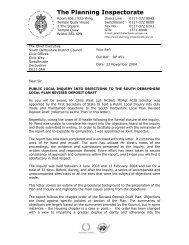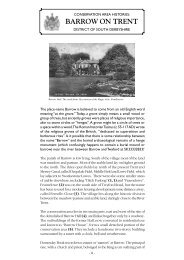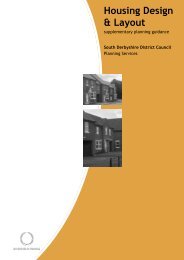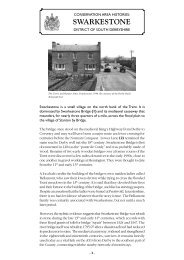Housing Strategy 2009-2014 - South Derbyshire District Council
Housing Strategy 2009-2014 - South Derbyshire District Council
Housing Strategy 2009-2014 - South Derbyshire District Council
You also want an ePaper? Increase the reach of your titles
YUMPU automatically turns print PDFs into web optimized ePapers that Google loves.
<strong>South</strong> <strong>Derbyshire</strong> <strong>District</strong> <strong>Council</strong> <strong>Housing</strong> <strong>Strategy</strong> <strong>2009</strong> – <strong>2014</strong><br />
7.6 Young People – Generally<br />
7.6.1 In the last two decades there has been a trend towards fewer young householders<br />
living in owner-occupied accommodation and more living in the private rented<br />
sector. In 2006, 52% 14 of 16 – 24 year olds lived in the private rented sector with<br />
only 30% living in the social rented sector. Those living in the rented sector tend to<br />
be single, where as those living in owner-occupation generally live with a partner.<br />
7.6.2 In <strong>South</strong> <strong>Derbyshire</strong> there is limited 1-bedroom accommodation available for<br />
young people to rent in both the private and social rented sector. Approximately<br />
6.3% of the private rented stock in the district is 1-bedroom. In the social sector<br />
the supply of 1-bedroom accommodation is somewhat higher (20%), however this<br />
is distorted as the majority is designated for older people.<br />
7.6.3 In terms of supported accommodation, there are currently two designated young<br />
persons’ accommodation projects, which operate in the district. A 32- bed Foyer<br />
scheme in Newhall and an 8-bed scheme designated for young vulnerable females<br />
including young single mothers in Swadlincote. Both schemes offer low-level support.<br />
7.6.4 In 2008, the Joseph Rowntree Foundation published a paper, which reviewed<br />
‘The <strong>Housing</strong> Choices and issues for young people in the UK.’ The key housing<br />
issues identified include:<br />
• Owner-occupation is beyond the means of most working-class young people.<br />
• Access to private rented housing may also be curtailed by landlords’<br />
preferences to rent to students and older tenants.<br />
• Student debt impacts negatively upon their likelihood of early entry to the<br />
property market.<br />
Key Issue: Limited accommodation for young people to rent<br />
in both the private and social housing sector.<br />
7.7 Young People – Vulnerable Groups<br />
7.7.1 Care Leavers: Transition to independence among care leavers occurs at a<br />
relatively young age, usually around 17. Care leavers are designated as a<br />
priority group for housing services under the <strong>Housing</strong> Act 1996. However, the<br />
Act fails to specify precisely who is responsible for prioritising their needs<br />
(housing or social services). The Children’s (Leaving Care) Act 2000 sought to<br />
ensure that enhanced support in the move to independent living is provided by<br />
Social Services. Under the Act, all care leavers are allocated a personal adviser,<br />
with responsibility for co-ordinating the provision of appropriate services.<br />
Support is provided until at least the age of 21 or completion of full-time education.<br />
14<br />
Source: English Household Surveys Live Table S102, available from:<br />
http://www.communities.gov.uk/documents/housing/xls/139265.xls<br />
23



